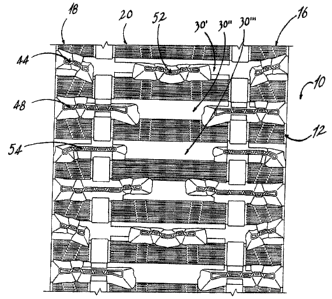Some of the information on this Web page has been provided by external sources. The Government of Canada is not responsible for the accuracy, reliability or currency of the information supplied by external sources. Users wishing to rely upon this information should consult directly with the source of the information. Content provided by external sources is not subject to official languages, privacy and accessibility requirements.
Any discrepancies in the text and image of the Claims and Abstract are due to differing posting times. Text of the Claims and Abstract are posted:
| (12) Patent: | (11) CA 2319934 |
|---|---|
| (54) English Title: | RUBBER-BAND TRACK WITH VARIOUS HARDNESSES |
| (54) French Title: | CHENILLE EN CAOUTCHOUC A DURETE HETEROGENE |
| Status: | Expired |
| (51) International Patent Classification (IPC): |
|
|---|---|
| (72) Inventors : |
|
| (73) Owners : |
|
| (71) Applicants : |
|
| (74) Agent: | BCF LLP |
| (74) Associate agent: | |
| (45) Issued: | 2004-11-09 |
| (22) Filed Date: | 2000-09-18 |
| (41) Open to Public Inspection: | 2002-03-18 |
| Examination requested: | 2001-01-29 |
| Availability of licence: | N/A |
| (25) Language of filing: | English |
| Patent Cooperation Treaty (PCT): | No |
|---|
| (30) Application Priority Data: | None |
|---|
The endless track is made of a reinforced rubber material with longitudinally spaced and transversely disposed ridges or lugs. It is particularly well-adapted for recreational snowmobiles having a single track. The track is characterized in that the rubber material of the central portion of the body has a hardness of between 75 and 90 duro A while the rubber material of the opposite band portions of the body has a hardness between 55 and 75 duro A. Such track facilitates the steering capabilities of a snowmobile, particularly when the snowmobile is traveling on hard and abrasive surfaces. It also improves the durability of the track.
La chenille est faite à partir d'un matériau en caoutchouc renforcé avec des crêtes ou crans espacés au niveau de la longueur et disposés de manière transversale. Elle est particulièrement bien adaptée pour les motoneiges récréatives du fait de sa chaîne unique. La chenille est caractérisée par le fait que sa partie centrale est faite en caoutchouc qui a une dureté comprise entre 75 et 90 a alors que les sections de la bande opposée sont en caoutchouc ayant une dureté comprise entre 55 et 75 a. Ce type de chenille rend la motoneige plus facile à diriger, notamment lorsque la motoneige se déplace sur des surfaces dures et abrasives. Elle améliore également la durabilité de la chaîne.
Note: Claims are shown in the official language in which they were submitted.
Note: Descriptions are shown in the official language in which they were submitted.

For a clearer understanding of the status of the application/patent presented on this page, the site Disclaimer , as well as the definitions for Patent , Administrative Status , Maintenance Fee and Payment History should be consulted.
| Title | Date |
|---|---|
| Forecasted Issue Date | 2004-11-09 |
| (22) Filed | 2000-09-18 |
| Examination Requested | 2001-01-29 |
| (41) Open to Public Inspection | 2002-03-18 |
| (45) Issued | 2004-11-09 |
| Expired | 2020-09-18 |
There is no abandonment history.
| Fee Type | Anniversary Year | Due Date | Amount Paid | Paid Date |
|---|---|---|---|---|
| Application Fee | $300.00 | 2000-09-18 | ||
| Request for Examination | $400.00 | 2001-01-29 | ||
| Registration of a document - section 124 | $100.00 | 2001-03-09 | ||
| Maintenance Fee - Application - New Act | 2 | 2002-09-18 | $100.00 | 2002-09-11 |
| Maintenance Fee - Application - New Act | 3 | 2003-09-18 | $100.00 | 2003-07-24 |
| Final Fee | $300.00 | 2004-08-11 | ||
| Maintenance Fee - Application - New Act | 4 | 2004-09-20 | $100.00 | 2004-08-11 |
| Maintenance Fee - Patent - New Act | 5 | 2005-09-19 | $200.00 | 2005-08-22 |
| Maintenance Fee - Patent - New Act | 6 | 2006-09-18 | $200.00 | 2006-09-14 |
| Maintenance Fee - Patent - New Act | 7 | 2007-09-18 | $200.00 | 2007-08-21 |
| Maintenance Fee - Patent - New Act | 8 | 2008-09-18 | $200.00 | 2008-05-14 |
| Maintenance Fee - Patent - New Act | 9 | 2009-09-18 | $200.00 | 2009-08-10 |
| Maintenance Fee - Patent - New Act | 10 | 2010-09-20 | $250.00 | 2010-08-17 |
| Maintenance Fee - Patent - New Act | 11 | 2011-09-19 | $250.00 | 2011-08-15 |
| Registration of a document - section 124 | $100.00 | 2011-12-05 | ||
| Maintenance Fee - Patent - New Act | 12 | 2012-09-18 | $250.00 | 2012-08-20 |
| Maintenance Fee - Patent - New Act | 13 | 2013-09-18 | $250.00 | 2013-08-21 |
| Maintenance Fee - Patent - New Act | 14 | 2014-09-18 | $250.00 | 2014-08-12 |
| Maintenance Fee - Patent - New Act | 15 | 2015-09-18 | $450.00 | 2015-08-18 |
| Maintenance Fee - Patent - New Act | 16 | 2016-09-19 | $450.00 | 2016-09-07 |
| Maintenance Fee - Patent - New Act | 17 | 2017-09-18 | $450.00 | 2017-09-18 |
| Maintenance Fee - Patent - New Act | 18 | 2018-09-18 | $450.00 | 2018-05-16 |
| Maintenance Fee - Patent - New Act | 19 | 2019-09-18 | $450.00 | 2019-09-06 |
Note: Records showing the ownership history in alphabetical order.
| Current Owners on Record |
|---|
| SOUCY INTERNATIONAL INC. |
| Past Owners on Record |
|---|
| DELAND, ANDRE |
| SOUCY, GILLES |
| ST-PIERRE, YVES |